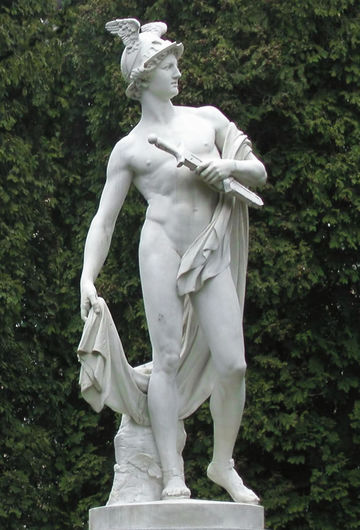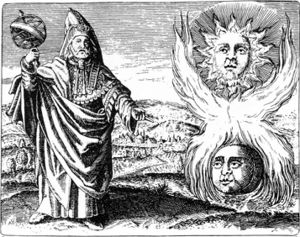Hermes Trismegistus

Hermes was known in ancient times as the great sage to whom is attributed sacred writings and alchemical and astrological works. Because of his learning and profound skill in the arts and sciences, the Egyptians gave him the name Trismegistus, which means “thrice-great.” The title “thrice-great” also applies to his role as philosopher, priest and king.
The ascended master Hermes Trismegistus is also known as the God Mercury. Hermes walked the earth for tens of thousands of years. He was on Atlantis, walked its streets, was in its temples and halls of learning and gave forth his teaching. He figures as the great archetype of the messenger of the gods.
James Campbell Brown writes in his History of Chemistry:
A series of early Egyptian books is attributed to Hermes Trismegistus, who may have been a real savant, or may be a personification of a long succession of writers.... He is identified by some with the Greek god Hermes [equated with the Roman god Mercury] and the Egyptian Thoth.... The Egyptians regarded him as the god of wisdom, letters, and the recording of time.[1]
The historical record
Until the seventeenth century, Hermes was thought to have been a contemporary of Moses. His writings were considered by Christians to be almost as sacred as the Bible. Church Father Justin Martyr even went so far as to compare him to Jesus. The Greek Church Father Clement of Alexandria spoke of forty-two “Books of Thoth” dealing with priestly education, temple ritual, geography, astrology, guidance for kings, hymns to the gods and medicine. Regrettably, these were lost in the burning of the library at Alexandria.
Scholars today tell us Hermes was an ancient Egyptian sage, or perhaps a succession of sages. They believe that a whole line of teachers or a priesthood may have written under the name Hermes. The prevailing theory is that the Hermetic writings may span several centuries, dating as late as the first or second century A.D.
According to an ancient Egyptian historian, Hermes wrote 36,525 books. His subjects included alchemy, astrology and theology. He was looked to as the custodian of wisdom and literature. In order to enlighten the people, Hermes had his instructions engraved in hieroglyphics upon tables or columns of stone throughout Egypt.
Some have placed Hermes in the time period before the Flood. Archaeologist James Churchward traces Thoth back to the days of Atlantis. The Egyptians honored Thoth as the god of wisdom, learning and literature. They saw him as the inventor of all arts and sciences, including writing, arithmetic, algebra, geometry, theology, political economy, medicine, surgery, music and musical instruments. He was believed to be the scribe of the gods.
Scholar Hargrave Jennings writes:
Another Thoth, or Hermes, is said to have lived at a later period. He was equally celebrated with the former, and to him is particularly appropriated, by some, the name of Trismegistus. According to Manetho [an Egyptian priest and historian c. 300 B.C.], he [this second Thoth] translated from engraved tables of stone, which had been buried in the earth, the sacred characters of the first Hermes. He wrote the explanation of them in books, which were deposited in the Egyptian temples.[2]

The emerald tablet
Hermes Trismegistus has been referred to as the father of alchemy. According to one legend, a slab of emerald found in his tomb had inscribed upon it Hermes’ precepts for making gold. This emerald tablet contained the familiar Hermetic axiom: “What is below is like that which is above. And what is above is like that which is below.”[3]
One ancient author who claimed to have seen the stone said that it was an emerald on which the characters were represented in bas-relief, not engraved. The material had once been in a fluid state like melted glass and had been cast in a mold, and it had been given the hardness of a genuine emerald by alchemical means.
The emerald tablet has long been regarded in the mystery schools as one of the oldest and most profound expositions of spiritual alchemy. It presents an alchemical formula that has been used by the adepts and alchemists for thousands of years to assimilate the most essential understanding of both physical transmutation and spiritual regeneration. However, its statements clearly hide to all but the true alchemist their inner meaning.
The ascended master Hermes has taught of the emerald tablet of the heart:
I, Hermes, messenger of the Gods and also the one called Mercury, have tarried, lo, these tens of thousands of years and beyond that there might be a torch of remembrance, an inscribing of the Law upon the emerald tablet of thy heart.
For, lo, the emerald tablet in the secret chamber of thy heart is even now unveiled by thine own Holy Christ Self, the priest-philosopher-scientist who officiates at the altar of unalterable change. It is that change that must come, that must be because I AM and because thou art also the God-man.
He instructed us to
... neglect not the heart; and call the sacred fire to melt and transmute daily all hardness of heart, spiritual neglect and records of death surrounding the sun center of your own heart chakra. Let us be diligent to expand the heart, for out of it are the issues of life.[4]
The Hermetic tradition
The Hermetic tradition teaches that it is through mystical experience that man attains liberation. Scholar Sidney Spencer writes:
The Hermetic mystic sees his unity with all beings. The purgation and illumination of the soul which he attains brings him the consciousness of universal fellowship, and it is his task to do good to all.[5]
In the Mahatma Letters the Master K.H. praises Hermetic philosophy:
Hermetic Philosophy suits every creed and philosophy and clashes with none. It is the boundless ocean of Truth, the central point whither flows and wherein meet every river, whether its source be in the East, West, North, or South. As the course of the river depends upon the nature of its basin, so the channel for the communication of Knowledge must conform itself to surrounding circumstances. The Egyptian Hierophant, the Chaldean Mage, the Arhat, and the Rishi, were bound in days of yore on the same voyage of discovery and ultimately arrived at the same goal though by different tracks.[6]
According to scholar Walter Scott, some of the Hermetic texts may have been written down by the pupils of Ammonius Saccas, a renowned third-century Alexandrian teacher and one of the founders of the Neoplatonic movement. He was a teacher of Origen. Helena Blavatsky considered that the most important goal of the Theosophical Society was to revive the work of Ammonius Saccas. Blavatsky wrote:
It was Ammonius who first taught that every religion was based on one and the same truth; which is the wisdom found in the Books of Thoth (Hermes Trismegistus), from which books Pythagoras and Plato had learned all their philosophy.[7]
Today, fewer than twenty sermons and some additional fragments of Hermes’ teachings remain. In 1945 three Hermetic tracts were discovered at Nag Hammadi, thus indicating a link between the Gnostic and Hermetic schools. The Gnostics, who flourished in the second century A.D., believed that the most important element in the soul’s spiritual quest was gnosis—a Greek word meaning “knowledge.” We see this same principle reflected in the Hermetic teachings. Scholar Giovanni Filoramo says:
The Hermes texts were written in the form of gentle scholarly dialogues in which Hermes teaches a closed group of disciples. They are imbued with an irrepressible desire for knowledge of God. Their ideological structure is an attitude of genuine, deep devotion as the way to knowledge of oneself and of God.[8]
The lineage of the planet Mercury
The ascended master Hermes is the sponsor of El Morya and of all those who have come from the planet Mercury. El Morya explains:
The lifewaves of sons and daughters of God who have evolved out of Mercury, who have served with Sanat Kumara and who now are dwelling on earth, come from an evolution that we knew long ago. In that planetary body, the issue of light and darkness was present....
As we saw the challenge and as we were taught by God Mercury, we knew that unflinching devotion to the will of God, the drawing within of energy to the diamond point of the Self, the wielding of the sword of blue flame, and the mastery of the action of fohatic keys would result in the victory....
God gave to us, as we fought the battle of worlds on Mercury, that energy, that power—only because we were willing to balance the threefold flame, to pursue wisdom and wisdom’s might, to intensify such love in every cell and in the flame of every cell, so that our auras were so saturated with love that there was no possibility for the misqualification of one erg of God’s power through any form of tyranny whatsoever....
Beloved ones, the victory of Mercury has not yet been concluded. A greater part of the victory was won, yet certain sons of light and certain fallen ones had not reached the culmination of their evolution. They were, therefore, assigned to other planetary homes and systems. Some of the fallen ones became aligned with the laggard evolutions that eventually embodied on earth. Some of the sons and daughters of God journeyed to Venus and later accompanied Sanat Kumara to earth.[9]

The arts of communication
Hermes calls those who would take up the arts of communication in defense of Truth:
I am a messenger of the Gods and I have a message that I must deliver to your hearts....
I speak of the lineage of the initiates of Mercury—those who have fashioned their skill by the sword and the pen, those who have acquainted themselves with the mind of God and have claimed that mind, who have come from a lineage that antedates myself. Truly, there is a lineage of those who have been called Hermes, the name being the title of an office. Thus, there is a descent of those whose craft has been to set forth in writing and in other forms of communication that which is Real, that which is unreal, that which is necessary information to the body politic round the world that they might know and understand the way to go....
There are those whom I myself have trained under my mantle as God Mercury. We who bear the shield and the armour of the Sun must therefore go up and down the nations of the earth and call out those who have the original communication skills, who practiced those skills in ancient times and on ancient continents and are willing to once again take the lead in the dissemination of the Truth and in exposing error. You must come forward! For the Truth must be made known....
Set forth the message! Set forth the platform for its delivery in your area of expertise! And if you think you have no expertise, go out and get it, and study and prove yourself to be one who will make that statement and make that name, not only for yourself but for God and all the ascending ones. I AM Hermes and I say to you: I shall overshadow any of you, each and every one of you, who will learn these disciplines.[10]
His service today
At the present time, Hermes serves in the retreat in Arabia where he is the patron of the science of alchemy—which Saint Germain has defined as the all-chemistry of God. His aura is a brilliant gold; he wears white robes and has long hair. He is the image of the ancient wisdom and the androgynous nature of the Deity.
See also
For more information
MP3 audio album Emerald Matrix: The Perfect Light includes a lecture on Hermes and a dictation by him.
Sources
Mark L. Prophet and Elizabeth Clare Prophet, The Masters and Their Retreats, s.v. “Hermes Trismegistus (God Mercury).”
- ↑ James Campbell Brown, A History of Chemistry from the Earliest Times till the Present Day (London: J. & A. Churchill, 1913).
- ↑ Hargrave Jennings, The Divine Pymander of Hermes Mercurius Trismegistus (San Diego, Calif.: Wizards Bookshelf, 1985), pp. iii, iv, v.
- ↑ Ibid., p. x.
- ↑ Hermes Mercurius Trismegistus, “The Emerald Tablet of the Heart,” Pearls of Wisdom, vol. 24, no. 73, August 1981.
- ↑ Sidney Spencer, Mysticism in Religion (London: Allen & Unwin, 1966), p. 147.
- ↑ The Mahatma Letters to A. P. Sinnett, compiled by A. T. Barker (Theosophical University Press, 1926), letter 85.
- ↑ H. P. Blavatsky, Isis Unveiled (Wheaton, Ill.: Theosophical Publishing House, 1972), vol. 1, p. 444.
- ↑ Giovanni Filoramo, History of Gnosticism.
- ↑ El Morya, “The Gemini Mind: For the Governing of Society and the Self,” Pearls of Wisdom, vol. 24, no. 43, October 25, 1981.
- ↑ Hermes Trismegistus, “The Guild of God Mercury: The Sword and the Pen,” Pearls of Wisdom, vol. 36, no. 42, September 22, 1993.
